Post by Mauro Fiorentini on Feb 4th, 2013 at 6:50pm
Hallo friends!
I'm not sure I should have posted this topic here, I was thinking about Other topics, but on the other hand I'm showing a warrior, so... Anyway I'm ready to move the thread if you don't like it here.
So, I'm pleased to show you my hypothetical reconstruction of a Picenian slinger, ca. 8th Century b.C.
Picenians lived in my Region at that time, and they were known for their skills as pirates and mercenaries. In fact, Rome hired them as allies first and auxiliaries later, and they were the only Italic population which the Romans had to deport in order to grant the pax Romana. Picenian nasty people :D
The warrior I had in mind was not a rich member of his tribe, which is shown by the lack of metallic equipment.
He's armed with an iron short sword of Balcanic origins (check here: http://slinging.org/forum/YaBB.pl?num=1338743737/0 and http://etadelferro.forumfree.it/?t=62356992) and his simple sling, a weapon of which use we have some evidences dating from the 6th to the 5th Century.
He wear a war belt made of reinforced leather, which he fasten with a simple bronze pin.
This belt will protect his lower stomach, while the chest is protected by the kardiophilax (check here: http://www.youtube.com/watch?v=G_-N3bspk-Y).
A kardiophilax was a very primitive kind of protection consisting of a couple of discs or a squares made by various materials and covering the heart and the back. Since my warrior is not rich, his kardiophilax is made of some layers of linen and a sheet of leather, hardened with the use of salted boiling water. Richer warriors and warlords had bronze kardiophilax with iron reinforcements.
Both the belt and the kardiophilax were common among the Iron Age populations in Central Italy, and a type of kardiophilax was produced in my Region. It can be easily recognized by its decorations, therefore I used these decorations for my version.
The warrior is protecting his head with a light cap made of some layers of linen, glued and sewn together. This kind of cap was very common at that time for we have many evidences: bronze and pottery figures from Region Marche, Umbria and Sardinia, a bark example from Southern Germany and a copper one from Region Veneto (check here: http://slinging.org/forum/YaBB.pl?num=1358701012).
The linen tunic is a typical short one, as can be seen in many frescoes, pottery and bronze figures of the time. It didn't change until Greek first, and then Roman fashion took its place.
Shoes are not shown for I'm still gathering sources on them.
I will soon add a more detailed review on my forum, and will update this page too.
Any comment would be much appreciated :)
Greetings,
Mauro.
I'm not sure I should have posted this topic here, I was thinking about Other topics, but on the other hand I'm showing a warrior, so... Anyway I'm ready to move the thread if you don't like it here.
So, I'm pleased to show you my hypothetical reconstruction of a Picenian slinger, ca. 8th Century b.C.
Picenians lived in my Region at that time, and they were known for their skills as pirates and mercenaries. In fact, Rome hired them as allies first and auxiliaries later, and they were the only Italic population which the Romans had to deport in order to grant the pax Romana. Picenian nasty people :D
The warrior I had in mind was not a rich member of his tribe, which is shown by the lack of metallic equipment.
He's armed with an iron short sword of Balcanic origins (check here: http://slinging.org/forum/YaBB.pl?num=1338743737/0 and http://etadelferro.forumfree.it/?t=62356992) and his simple sling, a weapon of which use we have some evidences dating from the 6th to the 5th Century.
He wear a war belt made of reinforced leather, which he fasten with a simple bronze pin.
This belt will protect his lower stomach, while the chest is protected by the kardiophilax (check here: http://www.youtube.com/watch?v=G_-N3bspk-Y).
A kardiophilax was a very primitive kind of protection consisting of a couple of discs or a squares made by various materials and covering the heart and the back. Since my warrior is not rich, his kardiophilax is made of some layers of linen and a sheet of leather, hardened with the use of salted boiling water. Richer warriors and warlords had bronze kardiophilax with iron reinforcements.
Both the belt and the kardiophilax were common among the Iron Age populations in Central Italy, and a type of kardiophilax was produced in my Region. It can be easily recognized by its decorations, therefore I used these decorations for my version.
The warrior is protecting his head with a light cap made of some layers of linen, glued and sewn together. This kind of cap was very common at that time for we have many evidences: bronze and pottery figures from Region Marche, Umbria and Sardinia, a bark example from Southern Germany and a copper one from Region Veneto (check here: http://slinging.org/forum/YaBB.pl?num=1358701012).
The linen tunic is a typical short one, as can be seen in many frescoes, pottery and bronze figures of the time. It didn't change until Greek first, and then Roman fashion took its place.
Shoes are not shown for I'm still gathering sources on them.
I will soon add a more detailed review on my forum, and will update this page too.
Any comment would be much appreciated :)
Greetings,
Mauro.
